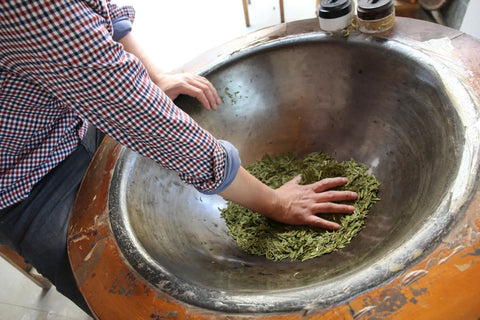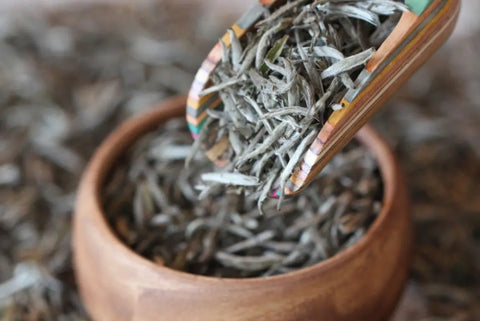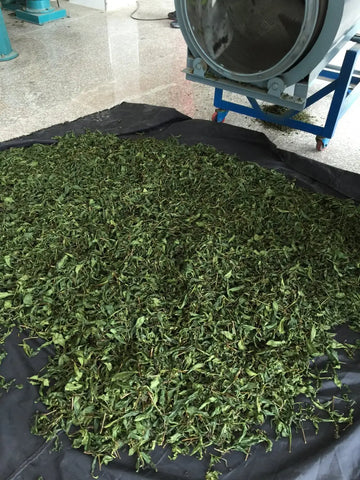
How Tea is Made
Sometimes when we see the price of high-quality tea, we wonder whether it’s worth it. We think the taste speaks for itself, but that’s not the only thing that’s taken into consideration. Everything from quantity available and skill of the artisan and more is taken into account.

One of the factors that determines cost happens to be how much labor it takes to make a tea, and while there are now “modern” methods that speed these processes up, such as using forced air to wither tea as opposed to sun drying, the result is an inferior tea relative those made according to traditional methods.
Let’s spend today’s post looking at how each tea is generally made so that we can appreciate what goes into producing one of our favorite beverages. It’s worth noting that specific teas can have nuances in their processing steps.
Green Tea: Green tea is processed by taking freshly picked tea leaves and quickly heating them to greatly slow the oxidation process. This initial heating usually happens by pan-firing in a large wok or steaming in a tray. By doing this so quickly, the tea leaves maintain their vibrant green color, almost as if they had been freshly plucked. At this point, an artisan heats the tea at a higher temperature to help preserve the integrity of the leaves while rolling, pressing or twisting them into their desired shapes. Green teas are then finished with one final act of pan-drying. Throughout each of these stages, artisans carefully tend to the leaves, sometimes hand tossing them while pan-drying. As you can imagine, hand-tossing leaves that are heated to 140°F and higher can get uncomfortable, but this is a way of life for many of these artisans and just adds to the value of the finished product.

Yellow Tea: Yellow tea is processed in a manner similar to green tea with the exception of an additional, labor-intensive and time-consuming step. After the tea leaves are rolled, they are then steamed and gathered together under a damp cloth or mat overnight. Every 1-3 hours, the artisan wakes up and takes the time to shift the leaves around. Sometimes the drying and smothering process takes place for many days depending on the artisan and technique. This makes yellow teas very difficult to make, and so they are truly a treasure to enjoy. This also makes yellow teas very rare, as many tea producers feel as though the time and effort spent taking the extra steps is not worth the demand for the tea. An unfortunate consequence is that important techniques used in producing yellow teas are being forgotten. This is one of the reasons why MeiMei Fine Teas supports yellow tea artisans!
White Tea: White tea is made by withering the initial, freshly plucked tea buds and leaves. Traditionally, the withering takes place in the sun or out in the open air, but some tea producers have experimented with withering the tea through forced air. We believe these “modern” methods produce inferior teas, and this is most noticeable in the taste. For that reason, our white teas are always produced according to traditional methods. Once the withering step is complete, the tea is then finished by air drying or baking. Because white tea usually involves only two steps, it is often referred to as “the least processed” tea.

Oolong Tea: Perhaps the greatest variety in terms of flavor, oxidation, and appearance occurs with oolong teas. Oolongs also have the greatest number of steps in their production, which is what contributes to such variety. Typical oolongs are prepared first by withering the tea leaves in sunlight or in the open air. Once the tea leaves have been partially dried out, they’re then aerated at room temperature or in the shade. During this time, many artisans elect to subject the tea leaves to a series of gentle agitations, usually by shaking them in a bamboo basket, in order to lightly bruise the leaves. They might repeat this process a number of times in order to achieve their desired result. Artisans then typically heat the tea leaves at a low temperature to help facilitate rolling or twisting them. The final step involves pan-drying the leaves at a high temperature to deactivate oxidizing enzymes. Unlike the pan-drying in the case of green tea, pan-drying oolong tea leaves is usually very labor-intensive, sometimes involving many cycles of exposure to high-heat for long periods of time, and sometimes that for intervals that last as long as 8 hours. Depending on the length of time involved in any of the steps prior to the final pan-drying, oolong teas end up going through anywhere from 20-80% of the oxidation process, which is why some oolongs almost look like a green tea while others look more like a black tea.

Black Tea: Black teas are usually regarded as "fully oxidized," which simply means that the tea masters let the oxidation process fully occur. Black tea production begins like white teas and oolongs by first being withered. They quickly depart from these two kinds of tea when the second step begins. This occurs when an artisan chooses to start bruising the leaves, usually by crushing, cutting, twisting, pressing, and so forth. Once they are finished, they lightly heat the leaves so that they can begin rolling them, and then they deactivate them in a final step of pan-drying at high heat. While oolongs tend to receive a lot of attention for their variety, novices don’t always realize that black tea can exhibit a lot of variety as well. Our Sichuan Imperial black tea, for example, is very different from our Keemun Imperial.
Pu-Erh Tea: Puerh tea has two subcategories, raw puerh ("sheng" in Chinese), whose process is somewhat similar to green tea, and cooked puerh (or "shu" puerh), which uses a post-fermenting process. The amazing tea has a dynamic terroir and flavor profile from a complex aging process that impart attributes similar to a fine wine. We will delve further into the processing of puerh tea in a separate blog.
Hopefully you now have a better understanding of how tea is processed, which can help you appreciate what’s in your cup just a little more!
